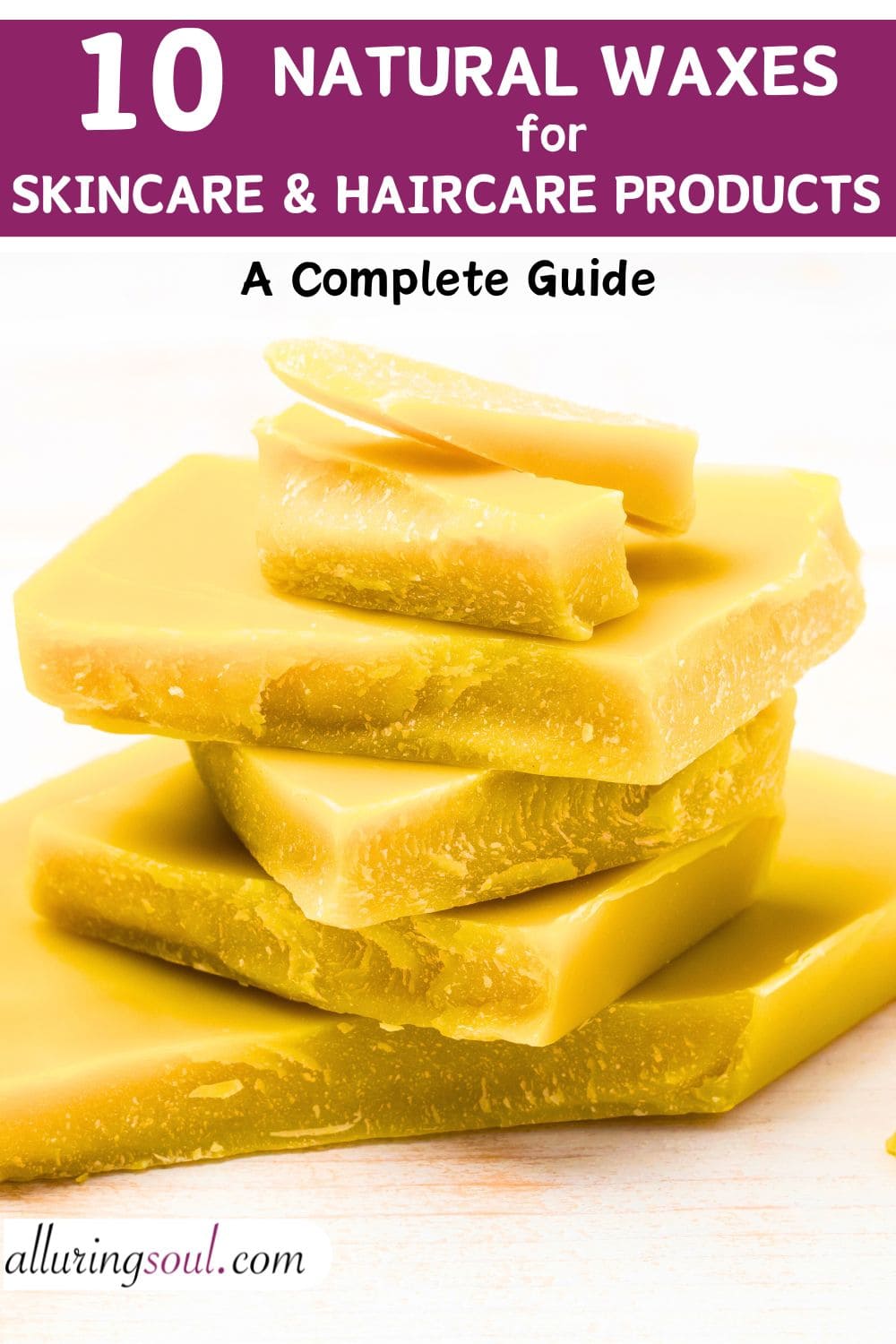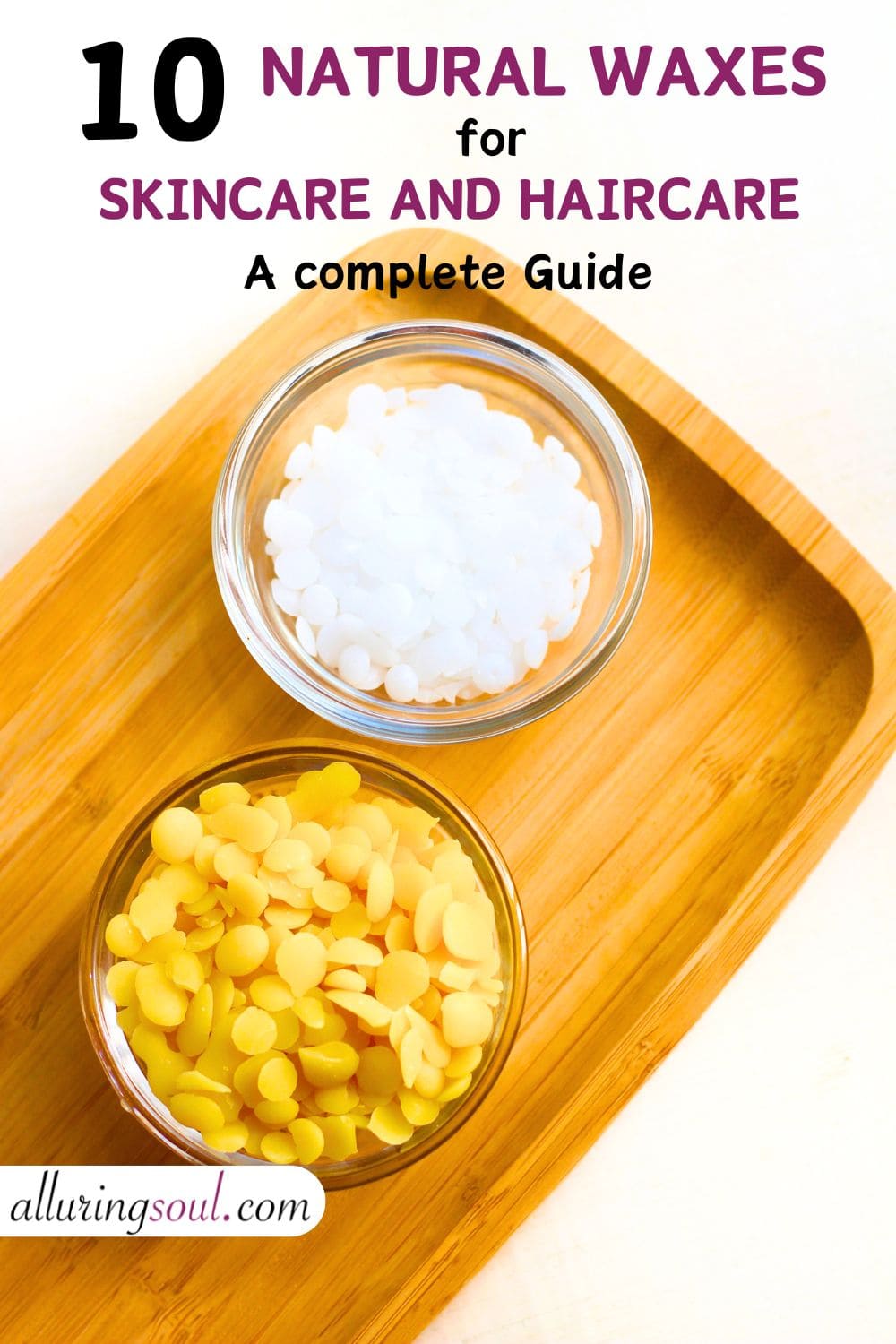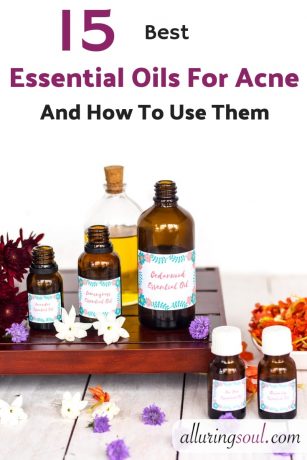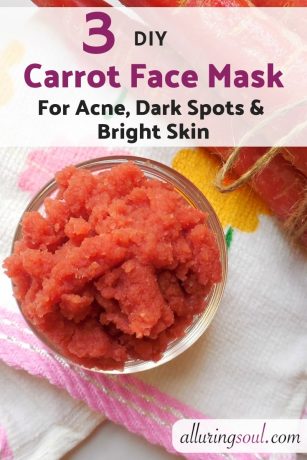Waxes are rapidly becoming popular in our skincare regime. These days, they are found everywhere from cleansing balms and body butters to facial oils and moisturizers. All-natural waxes have good emolliating properties. Additionally, they nourish the skin and add essential fatty acids and minerals to it.
This article delves into natural waxes and pseudo waxes, their benefits, and various types of pseudo and natural waxes that you can include in your skincare products.
What Is Natural Wax? How It Is Made?
Waxes are lipophilic solids composed of a variety of substances such as alcohols, esters, and fatty acids. They are generally insoluble in water, but soluble in other organic solvents.
Depending on the source from which the wax is extracted, waxes can be natural or synthetic. Natural waxes can be further classified into animal wax, plant wax, and mineral wax.
1. Plant Wax
The surface of leaves, stems, and cuticles of plants contains a waxy substance that prevents the evaporation of water from the surface. These waxes are called epicuticular waxes, and they contain fatty acids, alcohols, alkyl esters, ketones, diols, and aldehydes. Some examples of plant wax are soy wax, carnauba wax, and candelilla wax.
2. Animal Wax
As the name suggests, animal waxes are collected from living animals. The most popular animal waxes are beeswax, which is collected from the bees.
Beeswax is widely used in numerous cosmetic products as a sealing ingredient. It contains approximately 71% esters and 15% long-chain hydrocarbons along with other fatty acids and alcohols. Other examples of animal wax are lanolin from the wool of the sheep and spermaceti from sperm whales.
3. Mineral Wax
The difference between mineral wax and other forms of natural wax is that mineral waxes are made from dead remains of plants. Mineral waxes or paraffin are derived by fractional distillation of petroleum. Mineral waxes contain long chains of hydrocarbons along with alkanes, naphthenes, and other aromatic compounds.
Why Waxes Are Used In Cosmetics?
Waxes are predominantly used in several cosmetic products such as balms, moisturizers, waterproof makeup, and even sunscreens. This is because waxes are hydrophilic in nature, meaning that they can repel water. This property helps waxes become an excellent emollient and waterproof base for makeups.
The reasons why waxes are used in cosmetics are as follows:
1. Waxes Are Used As An Emollient –
Waxes are known for their protective, barrier-reinforcing properties. This makes them good emollients for moisturizers. Waxes can form a protective film on the skin that does not allow moisture to escape from the upper layers of the skin.
The emolliating properties of waxes are best utilized in moisturizers for dry skin. Additionally, some waxes also have the ability to block the harmful rays of the sun and are resistant to wearing off.
2. Waxes Are Used As A Thickening Agent –
For most skincare products, the texture of the product can make a huge difference. When natural waxes are added to lotions and body butter, they act as a thickening agent.
Waxes can improve the smoothness and consistency of skincare products. They add volume to the products and enable easy application on the skin.
3. Waxes Are Used As A Waterproof Ingredient –
Being hydrophobic in nature, wax does not dissolve in water. This property of wax helps in formulating waterproof makeup that is not washed away easily due to sweat or rain. Using wax in makeup products also makes them non-transferable and helps them to stay on the skin for a long time.
4. Waxes Are Used As A Formulating Stick In Makeups –
Waxes are needed in cosmetic products like lipsticks and lip balms. This is because wax helps to maintain the structure of the stick without making the product too stiff.
Using waxes in cosmetics helps to make the product creamy and smooth, without altering its structure. Additionally, it helps in the easy application of the product, without seeming too grainy or rough on the skin.
What Are The Benefits Of Using Natural Wax In Skincare And Haircare Products?
The benefits of using natural waxes in skincare and haircare products are as follows:
- All-natural waxes act as good emollients. They form a protective film over the upper layer of the skin so that the moisture cannot escape. This is the reason why natural waxes are used in moisturizers and body butter for dry skin.
- Waxes are also useful in hydrating and nourishing dry, chapped lips. Since the skin of the lips is soft, it is more susceptible to drying up. Almost all lipsticks and lip balms use natural waxes to prevent the formation of cracks on lips.
- Natural waxes are free from harmful, carcinogenic chemicals that are present in synthetic waxes. They are also hypoallergenic and thus suitable for all skin types.
- Natural waxes also have the ability to combat several skin concerns. They are used to reduce the appearance of stretch marks and prevent the formation of wrinkles, fine lines, and other signs of aging.
- Most natural waxes bring a lustrous finish to the surface of the skin and hair. By using them in skincare products, your skin can look radiant and glowing. Some hair masks and conditioners also contain natural waxes to bring a glossy finish to dry hair.
- Natural waxes also have a beneficial effect on the hair. They form a thin oily coating along each hair strand. This protects the strands from damage, breakage, and entangling. Natural waxes also nourish the hair follicles and reduce hair fall.
What Are The Types Of Natural Waxes Used In Skincare And Haircare Products?
The following are the various types of natural waxes used in skincare and haircare:
1. Beeswax
INCI: Cera Alba
Appearance: Yellow to white waxy solid
Beeswax, as the name suggests, is made from the secretions of Apis honeybees. They are the earliest and most natural source of wax. Since the process of manufacturing wax involves bees, beeswax is neither vegan nor cruelty-free.
The chemical composition of beeswax involves esters of long chains of fatty alcohols, with oleic acid, cerotic acid, palmitic acid, and palmitoleic acid. Depending on the degree of refining, the color of beeswax may vary from white to yellow.
When beeswax is used in combination with borax, it helps to stabilize emulsions and hold water and oil phases together.
Beeswax improves the longevity of products on the skin and does not wash off easily. Additionally, it helps to bring a luster to cosmetic formulations such as mascara and lipsticks.
Another benefit of beeswax is that it can thicken skincare products and make them more viscous. It also has anti-inflammatory & antibacterial properties and has the ability to repair the barrier of the skin and act as an emollient for dry skin.
2. Lanolin
INCI: Lanolin
Appearance: Yellow, waxy substance
Lanolin is produced by the sebaceous glands in the skin of the sheep to protect and condition the wool. Although it is comparable to the sebum produced by human skin, it lacks triglycerides.
To extract lanolin, the wool is sheared from the sheep and put in the centrifuge machine. The machine separates the wax from the chemicals and other solids present in wool.
As it is extracted from sheep, lanolin is not a vegan product.
Lanolin is very useful for the skin. It forms a protective film on top of the skin that locks the moisture in. Being an emollient and occlusive agent, it can slow down transepidermal water loss. This is the reason why lanolin is used in the treatment of dry, chapped lips, and cracked heels.
Lanolin also has the ability to store water twice its molecular weight and helps in keeping the skin plump with a reduced appearance of wrinkles.
Additionally, lanolin is used in hair care products as it can combat dryness of the scalp, rough and frizzy hair, and prevent dandruff. It can also condition the hair and eliminate the static charges along the strands of hair.
3. Sunflower Wax
INCI: Helianthus Annuus Seed Cera
Appearance: Pale, yellow solids
Sunflower wax is widely used in cosmetic products. It is extracted from the seeds of sunflowers and is a fully vegan product.
Sunflower wax has 70% wax esters and 30% hydrocarbons. It mainly consists of saturated esters of long-chain fatty acids and alcohols. The most important esters present in sunflower wax are behenyl acetate, lignoceryl acetate, and lignocerate.
Sunflower wax is mainly utilized for its oil-binding properties. It can attach to oil particles very well and stabilize emulsions. Additionally, it adds a lubricating effect to cosmetic products like lipsticks and helps them to glide on the skin without feeling rough.
Sunflower wax also helps to maintain the structure of lipsticks, lip balms, and deodorant sticks. It can thicken skincare products, and act as an emollient so that the skin does not lose moisture.
4. Candelilla Wax
INCI: Euphorbia Cerifera Cera
Appearance: Deep yellow pellets
Candelilla wax is widely used as a substitute for beeswax. This wax is extracted from the leaves of a Mexican shrub called Euphorbia antisyphilitica and is thus a vegan product.
The main use of candelilla wax is as a thickener. It increases the viscosity of products and makes moisturizers and balms creamy and glossy. Besides, candelilla wax also has emolliating and moisture replenishing abilities.
Candelilla wax is also useful for keeping the skin soft and moisturized as it has barrier-repairing properties. It also helps to keep wrinkles, stretch marks, and dark spots at bay. Additionally, candelilla wax can be used to treat common scalp issues such as dandruff, dryness, and itching.
5. Rice Bran Wax
INCI name: Oryza Sativa Cera
Appearance: Pale yellow solid
Another vegan wax that has multifaceted use is rice bran wax. It is extracted through the dewaxing of virgin rice bran oil.
The composition of rice bran wax is fatty acids like palmitic acid, behenic acid, and lignoceric acid, along with long-chain alcohols like cetyl alcohol. Bran bran wax also has squalene and phospholipids.
Rice bran wax serves as a good substitute for carnauba wax. It has very good oil binding properties. This makes it useful as an emulsifier(not a complete emulsifier) and emollient.
Rice bran wax can prevent the loss of moisture from the upper layers of the skin. It can keep the skin soft. Additionally, it helps skincare products maintain their creamy texture and spread evenly on the skin.
6. Carnauba Wax
INCI: Copernicia Cerifera Cera
Appearance: white waxy solids
Also known as Brazilian wax or palm wax, carnauba wax is the most versatile of all waxes used in cosmetics. Since carnauba wax is extracted from the leaves of the palm tree, it is a vegan product.
Carnauba wax has a high melting point, which ensures that cosmetics like lipsticks and lip balms do not melt easily. Additionally, it has good oil-binding properties and is used to stabilize emulsions.
Another use of carnauba wax is as a thickening agent. It adds volume and texture to the final product, making it glossy and smooth for easy application.
Carnauba wax is also very useful in formulating waterproof cosmetics. Due to its hydrophilic nature and ability to bind to any substance, such as oil or resin, it stays on the skin for a long time.
7. Berry Wax
INCI: Rhus Verniciflua Peel Cera
Appearance: Soft, pale white waxy solids
Berry wax is a soft wax. It is extracted from the peels of berries of the varnish tree and is a vegan product. The main constituents of berry wax are palmitic acid, stearic acid, heneicosanoic acid, a unique C21 acid, along with cetyl alcohol and cetearyl alcohol.
Berry wax has a low melting point and imparts a gel-like consistency on cosmetic products. It has the ability to spread evenly on the surface of the skin and keep it smooth and moisturized.
Berry wax is predominantly used in soft cosmetic products such as eyeliner pencils. It can also be used in lip balms in conjunction with a high melting point of wax to deliver a smooth texture to the lips.
8. Myrica Fruit Wax
INCI: Myrica Cerifera Fruit Wax
Appearance: Soft, white pellets
Myrica fruit wax is derived from the peels of the bayberry, a fruit that is native to parts of South America. It is a soft wax and fully vegan product.
Similar to berry wax, myrica fruit wax is used in cosmetics that require softness and easy movement along the skin without feeling coarse. It is primarily used in liner pencils.
Myrica fruit wax is also useful in stabilizing emulsions. It can also be used in hair styling products to give proper definition and volume to the styled hair without damaging the strands.
What Are Pseudo Wax? Are They Real?
Pseudo wax, as the name suggests, is not actual wax. These are by-products or residues that remain after the extraction of floral absolutes. Once the useful products are extracted from flowers, the remaining compounds are treated with alcohol, and the final substance that remains is called floral wax.
Pseudo waxes are generally dark in color and very expensive. These waxes offer very limited benefits in cosmetics. Their primary role is to impart fragrance to balms and other skincare products.
What Are The Types Of Pseudo Waxes Used In Skincare And Haircare Products?
The major variants of pseudo waxes that are used in cosmetic formulations are:
1. Floral Wax
Floral waxes are by-products of flowers. When flowers are chemically treated using solvents to get their aromatic extracts, the solid waste that is left behind is processed into floral wax.
Floral waxes preserve the light aroma of flowers and are used mainly in lip balms, fragrances, and lotions to impart the essence of flowers. Due to the incorporation of fragrances, floral waxes are more expensive than standard waxes.
Floral waxes are hard and have a dark tint to them. They are hard to melt and can burn easily.
Floral waxes have beneficial properties like moisturizing the skin, soothing the skin, treating skin rashes, and reducing signs of aging like wrinkles. However, they need to be liquified and diluted with a carrier oil so that they do not trigger any allergic reaction on the skin.
Some of the popular floral waxes are:
- Rose Wax: Rosa Damascena Flower Cera
- Jasmine Wax: Jasminum Grandiflorum Flower Cera
- Cassie Wax: Acacia Farnesiana Flower Cera
- Magnolia Wax: Michelia Alba Wax
2. Hydrogenated Oil Wax
Hydrogenated oil waxes are derived from vegetable oils like castor oil and palm oil. Using the process of hydrogenation, vegetable oils are transformed into trans fatty acids that solidify to form wax.
The process of hydrogenation of vegetable oils involves several factors like extremely high temperatures, hydrogen gas, and metal catalysts such as copper, cadmium, and aluminum.
Hydrogenated oils are completely safe for the skin and are suitable for use in skincare. They are emollients that soften and moisturize the skin.
The main hydrogenated oil-based waxes are as follows:
- Castor wax: Hydrogenated castor oil
- Palm wax: Hydrogenated palm oil
- Soy wax: Hydrogenated soybean oil
- Canola wax: Hydrogenated canola oil







No Comments